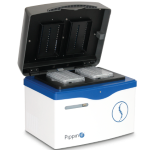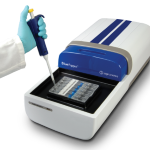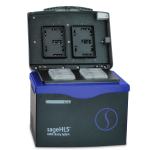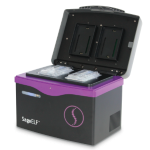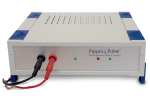Decimated little brown bats show potential for adaptive change
April 2020
Authors:
Giorgia G. Auteri & L. Lacey Knowles
Info:
Little brown bats have experienced a 90% population decline due to fungal pathogen that causes a disease, white-nose syndrome. The authors used ddRADseq to compare surviving and non-surviving individuals. The results indicate shifts in allelic frequencies in genes associated with responses to the disease, suggesting evolutionary adaptation to the syndrome.
Pippin Prep was used to size-select ddRad libraries.
Author Affiliations:
Department of Ecology and Evolutionary Biology and Museum of Zoology, University of Michigan, Ann Arbor, MI
Citation:
Nature Scientific Reports
DOI: 10.1038/s41598-020-59797-4
A restriction enzyme reduced representation sequencing approach for low-cost, high-throughput metagenome profiling
April 2020
Authors:
Melanie K. Hess, Suzanne J. Rowe, Tracey C. Van Stijn, Hannah M. Henry, Sharon M. Hickey, Rudiger Brauning, Alan F. McCulloch, Andrew S. Hess, Michelle R. Kirk, Sandeep Kumar, Cesar Pinares-Patiño, Sandra Kittelmann, Graham R. Wood, Peter H. Janssen, John C. McEwan
Info:
The authors present a restriction enzyme reduced representation sequencing (RE-RRS) method for metagenome profiling of livestock rumen microbial communities. The researchers correlate the profiles with methane production from the animals and compare results to previous 16S sequencing benchmarks.
Pippin Prep was used to size-select amplified sequences.
Author Affiliations:
AgResearch Limited, Invermay Agricultural Centre, Mosgiel, New Zealand
AgResearch Limited, Ruakura Agricultural Centre, Hamilton, New Zealand
AgResearch Limited, Grasslands Research Centre, Palmerston North, New Zealand
Citation:
PLOS One
DOI: 10.1371/journal.pone.0219882
Inhalation of lung spheroid cell secretome and exosomes promotes lung repair in pulmonary fibrosis
February 2020
Authors:
Phuong-Uyen C. Dinh, Dipti Paudel, Hayden Brochu, Kristen D. Popowski, M. Cyndell Gracieux, Jhon Cores, Ke Huang, M. Taylor Hensley, Erin Harrell, Adam C. Vandergriff, Arianna K. George, Raina T. Barrio, Shiqi Hu, Tyler A. Allen, Kevin Blackburn, Thomas G. Caranasos, Xinxia Peng, Lauren V. Schnabel, Kenneth B. Adler, Leonard J. Lobo, Michael B. Goshe & Ke Cheng
Info:
Collaborators at North Carolina State University report success treating Idiopathic pulmonary fibrosis (IPF) with inhalation treatment with lung spheroid cell-secretome and exosomes using mouse models. IPF is a fatal and incurable form of interstitial lung disease in which persistent injury results in scar tissue formation.
Pippin Prep was used to isolate microRNA sequencing libraries for studying the microRNA profile of exosomes post-treatment.
Author Affiliations:
North Carolina State University, Raleigh NC
Citation:
Nature Communications
DOI: 10.1038/s41467-020-14344-7
A spontaneous complex structural variant in rcan-1 increases exploratory behavior and laboratory fitness of Caenorhabditis elegans
February 2020
Authors:
Yuehui Zhao, Lijiang Long, Jason Wan, Shweta Biliya, Shannon C. Brady, Daehan Lee, Akinade Ojemakinde, Erik C. Andersen, Fredrik O. Vannberg, Hang Lu, Patrick T. McGrath
Info:
Researchers studying genetic adaptive changes using C. elegans recombinant inbred lines (RIL). A single RIL with a high fitness and exploration phenotype was observed that did not share these traits relative to the parental strains. Short-read sequencing indicated a spontaneous complex rearrangement of the rcan-1 gene. This rearrangement was resolved into five unique tandem inversion/duplications using Oxford Nanopore long-read sequencing. The authors suggest that colonization of new environments can create evolutionary pressure to produce complex rearrangements that can act to modify gene expression in ways besides increased gene dosage.
BluePippin was used to size select 10-50kb DNA fragments for Oxford Nanopore MinION library preparation.
Author Affiliations:
Georgia Institute of Technology, Atlanta, Georgia
Northwestern University, Evanston, Illinois
Citation:
PLOS Genetics
DOI: 10.1371/journal.pgen.1008606
Amplification-free long read sequencing reveals unforeseen CRISPR-Cas9 off-target activity
February 2020
Authors:
Ida Höijer, Josefin Johansson, Sanna Gudmundsson, Chen-Shan Chin, Ignas Bunikis, Susana Häggqvist, Anastasia Emmanouilidou, Maria Wilbe, Marcel den Hoed, Marie-Louise Bondeson, Lars Feuk, Ulf Gyllensten, Adam Ameur
Info:
In this preprint, the authors propose a method for screening for off off-target CRISPR/Cas9 sites using PacBio and Oxford Nanopore sequencing. The amplification-free method purifies and sequences both on-target and off-target cut sites from a DNA sample. The method could prove useful for improving gRNA design and screening and suggests the ability to develop de Novo guides as opposed to requiring a reference genome. SageELF was used to fractionate (1-18KB) SMRTBells for PacBio Hi-Fi circular consensus sequencing.
Author Affiliations:
Uppsala University, Sweden
Broad Institute of Massachusetts Institute of Technology and Harvard, Cambridge, MA
Boston Children’s Hospital, Boston, MA
Monash University, Melbourne, Australia
Citation:
bioRxiv
DOI: 10.1101/2020.02.09.940486
